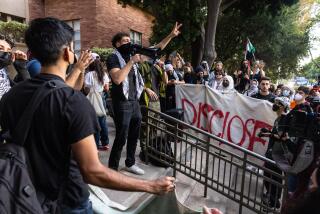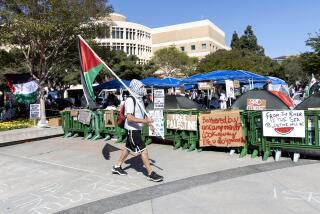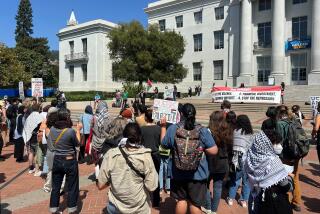Anti-War Protests Widen by Students : Demonstrations: USC and UCLA hold large, lively rallies in opposition to Persian Gulf battle. Hundreds are arrested throughout the nation.
- Share via
The second day of a widening war in the Middle East escalated student protests at UCLA, USC and many other universities nationwide Thursday, and hundreds were arrested as sometimes militant street demonstrations continued in cities large and small.
Anti-war activists and students favoring the military action angrily confronted each other at USC. An estimated 1,500 students rallied at UCLA, meanwhile, with about 300 later staging a sit-in inside the UCLA administration building.
The dissent at Los Angeles’ two most prominent universities reflected anger and soul-searching, and was met with an emerging backlash from students and others who urged Americans to support the military effort. Both sides claimed their values to be patriotic.
In San Francisco, scene of the nation’s most volatile protests, residents weathered a third day of raucous demonstrations that involved thousands of protesters, massive traffic tie-ups, clashes between police and marchers--and more than 800 arrests. A New York City march involving about 5,000 people was marred when a car collided with protesters on the Brooklyn Bridge, injuring seven. The driver was charged with drunken driving. In Eugene, Ore., authorities were investigating an arson fire at a Marine Corps recruiting station.
Symbols dramatized the human cost of war. Protesters employed body bags in demonstrations in Boston, Philadelphia and Pittsburgh. In Los Angeles, nine activists poured 40 gallons of oil and two pints of blood on the marble steps of the downtown federal building and then waited for arrest. Demonstrators found it ironic when maintenance workers poured sand on the steps to soak up the blood and oil.
The crisis had many people struggling to reconcile anti-war sentiments with concern for U.S. troops engaged in the battle. Clerics called for prayer services, some advocating civil disobedience to protest the war, and universities organized “teach-ins” to air divergent views. On the campuses, many students ignored the rallies.
Every view could be found at USC and UCLA.
In front of the Tommy Trojan statue at USC, what was planned as a lunchtime rally against the war turned into a spirited and sometimes bitter shouting match between students.
Peace songs from the ‘60s vied for attention with the hanging of an effigy of Saddam Hussein. Chants of “Go Desert Storm!” tried to drown out what seemed to be the stronger cries of “Peace Now.”
University officials estimated that about 850 attended the rally, saying it was the largest political gathering in many years at USC, which is a reputation for conservatism. No one was arrested, although campus police had to head off a couple of near fist fights.
“We don’t want to legitimize what George Bush is doing. And we certainly don’t want to legitimize what Saddam Hussein is doing either. We say there is a third way and that is peace,” said Jason Metter, a sophomore philosophy and political science major.
Tyrone Ferguson, a junior, stirred emotions. “I love our troops,” he said. “But I want them home to go to the parties, to go to the nightclubs, to go to the churches, to go to the synagogues, to go to the mosques.” Then he urged protesters to donate blood not to help the war effort, but to help the casualties.
Meanwhile, a sizable contingent of Bush Administration supporters waved small American flags and carried placards with such slogans as “Appeasement Does Not Bring Peace.” Bryan Dougall, a senior, said an Allied withdrawal now “would mean a loss of confidence in America and its institutions and that Americans would not be safe to travel anywhere in the world.”
At UCLA, organizers said the crowd of demonstrators was triple the size of a rally staged just before fighting broke out.
Students listened as Sondra Hale, a lecturer in women’s studies, exhorted the crowd: “Make them tell us how many people have been killed in Iraq already. Make them show us the faces of our so-called enemies. Make them show the women and children and civilians because if we saw one single face of the people they’re bombing they would have to stop this madness.”
Cheers stopped when a student Than Luu, a Vietnamese immigrant, told the crowd: “Now that we’re in war we should unify and support the troops.” Boos and hisses rose from some protesters, but they quieted when other students demanded that Luu be heard.
Luu read from prepared notes, his hands trembling as he described how many years before, his father carried him across a rice paddy as U.S. bombs fell from above. His father, he said, later explained that U.S. effort, saying, “I would rather die in the thunders of freedom than under the knife of a dictator.”
Protesters later moved on to Murphy Hall, the administration offices, for a sit-in that lasted into the night. Rather than arrest students for trespassing, officials decided to keep the building open.
Anti-war activist Ron Kovic addressed some 1,500 students outside the administration building before joining other protesters inside.
“This a crucial moment in your lives,” Kovic told the students, who listened in rapt silence to the wheelchair-bound Vietnam veteran. “You have an opportunity to take a stand in behalf of life, a stand Martin Luther King would have wanted you to take.”
At UC Santa Barbara, where about 3,000 students rallied against the war, a group of anti-war demonstrators cut short a press conference being held by Barbara Bodine, an official at the American Embassy in Kuwait at the time of the Iraqi invasion, school officials said. Bodine had been relating her experiences in the Gulf, but was shouted down, officials said.
A march in Santa Cruz was joined by UC Santa Cruz students who were boycotting classes. Protesters closed California 17 for the second straight night Thursday.
Meanwhile, UC Berkeley, traditionally a center of student protests, was quiet; students there are on winter break. Stanford students also held a small rally, but organizers said many students opposed to the war had traveled to San Francisco to join in major demonstrations there.
The San Francisco protests began with about 2,000 people surrounding the federal building. They then marched downtown to blockade the Pacific Stock Exchange and run onto freeway ramps in an unsuccessful bid to block the Bay Bridge for the third time in as many days.
Some bottles were thrown and minor scuffles occurred as federal employees unsuccessfully sought to break through the protest lines. Assorted slogans were sprayed onto the building, as well as the State Building across the street. Overall, there was little violence.
Mayor Art Agnos said arrests Thursday had pushed the total number over the last three days above 1,400.
Agnos, angered by scattered fire-setting and vandalism during Wednesday’s mass demonstration, urged demonstrators to “respect a standard of peace in our own city” and warned that the city’s tolerance for protest will not extend to violence against people or property. “Peace is the best message San Francisco can send,” he said.
Also contributing to this report were Times staff writers Shawn Hubler, John Dart, Tina Anima, Hector Tobar and Dean Murphy in Los Angeles; Mark Stein, Phil Hager and Dan Morain in San Francisco; Paul Feldman in Phoenix; Miles Corwin in Santa Barbara and correspondent Tracy Shyrer in Chicago.
More to Read
Sign up for Essential California
The most important California stories and recommendations in your inbox every morning.
You may occasionally receive promotional content from the Los Angeles Times.











